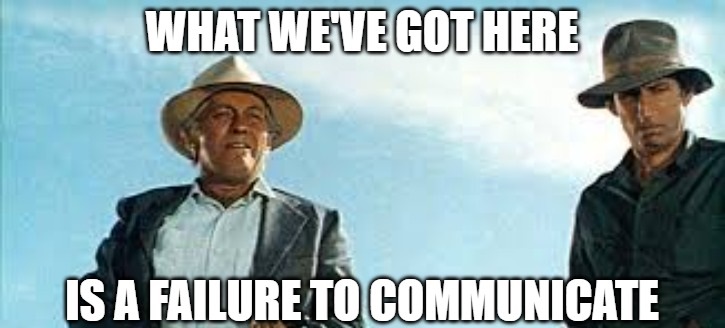Note: this is part one of a three part series. See part two ![]() here, which explains how this tip can be used to help limit your time spent in meetings. Part three, which explains how to scale weekly summaries up through an organization, can be found
here, which explains how this tip can be used to help limit your time spent in meetings. Part three, which explains how to scale weekly summaries up through an organization, can be found ![]() here. If you want to write a status report instead, check out
here. If you want to write a status report instead, check out ![]() this post.
this post.
If you read tech blogs at all, you’ll come across hundreds of “do these simple things to elevate your career,” or some other buzz-worthy headline. And you’ll read it, and if you’re like me, think “thanks for the high level information I already knew with no examples or data to explain or prove the value…” /sarcasm. So, what’s this post, then? Well, my own version, of course! But with a few key differences:
- I am only going to talk about one thing, and when you read it, you might think “that’s way too simple; no way.”
- By the end of this post, you will have all you need to respond to a clear Call to Action (CTA): try it. And not just once, but for a full 90 days to make it a permanent change.
OK, but way to bury the lead – what is this magical tip? Like I said, it’s simple: at the end of every week, write a summary of the week. And then share it at least with your manager. This is sometimes called the 5-15; a summary that takes no more than 15 minutes to write and 5 minutes to read.1 That’s it; I told you it was simple!
OK, but I have so many questions – what does this summary look like? Should I share it with others too? What if I’m not comfortable sharing this publicly; can it be private? All these questions and more will be answered below.
Why should I do this?
Before we talk about tactical details of what your summary should look like or how to share it, it’s important to start with why this is valuable. And of course, this will inform the what and how later on. In other words, we need to identify the problems we’re solving before we talk about the solution. So, why should one do this?
1. To hold yourself Accountable.
Whoa, whoa, whoa – why would I want to do that? I hear this a lot, actually. But look at the definition of accountable:
capable of being explained
That’s not so scary, is it? In fact, I want this. Who doesn’t want to be able to explain themselves, be it proactively or reactively? With your weekly summary, you get to share what you completed, what has changed since last week, and if you discovered any “ruh roh” items that need to be shared. In other words, you have a weekly changelog which can be used to explain said changes.
But there’s another secret I’ll let you in on: I am my own audience. Raise your hand if you ever forget anything; I know I do 🙋♂️. It’s OK; it’s natural; it’s human.2 Well, your weekly summary will help with this. It serves as your “to do” list, and if you forget something, you guarantee you won’t let it slip for longer than one week.
At the start of every week, I read my summary from the previous week so that I can remember my goals for the week. While this is important no matter your role, if you are a Technical Program Manager (TPM) like I am, you probably juggle a lot of balls at one time. I appreciate the help from “past Straker” to prevent dropping said balls!3 With that mindset, writing for yourself should be fun. The importance of this cannot be understated; it’s how I’ve managed to continue doing this task for years.
2. To enable both you and your manager to Objectively Evaluate your performance.
In any industry, you’ll hear about objective evaluation of performance – but how does one actually do this? Typically, tech companies evaluate employees once or twice a year. They do this by combining peer feedback with a self-review and then outputting a rating or grade. This evaluation is often called a “performance review.” While you indirectly control your peer feedback, you directly control your self-review, a significant input to your overall rating. So, raise your hand if you remember all that you accomplished over the past year; I know I don’t 🙍♂️.
If you don’t write down your accomplishments throughout the year, your self-review is likely to suffer from recency bias:
a cognitive bias that favors recent events over historic ones…It commonly appears in employee evaluations, as a distortion in favor of recently completed activities or recollections…
That’s right – this issue is so prevalent in employee evaluations that Wikipedia specifically highlights it.
So how do weekly summaries help with this problem? Well, if you keep a running tally of all of your weekly summaries – perhaps via tools like OneNote or Google Docs – you now have the longest appendix for your performance review ever.
OK, but there’s no way anyone is reading 52 weekly summaries as part of a performance review. While true, when you complete a notable task, you can copy the task into a section with all of your completed tasks for the year. Then before writing your performance review, you can use this list as a reminder of all you’ve accomplished since the last one – even if it’s something you did a year ago and completely forgot about. And you can use this filtered list as your appendix, which should be anywhere from a half page to a couple of pages.
3. To Asynchronously Communicate effectively with your peers, managers, and stakeholders.
If you ever read about remote culture, you’ll quickly run into the term “asynchronous communication” and its importance in remote culture. But what is asynchronous communication? I talk about it in another post of mine, ![]() Remote Work is Here to Stay: A Remote Manifesto, but for a full writeup, checkout 37Signals’ guide for internal communication. And yes – your weekly summary is an excellent example of asynchronous communication.
Remote Work is Here to Stay: A Remote Manifesto, but for a full writeup, checkout 37Signals’ guide for internal communication. And yes – your weekly summary is an excellent example of asynchronous communication.
But what if I am not in a remote environment? Weekly summaries are still helpful. Maybe your team is spread out across locations, so you’re not always able to be in person together. Or maybe you have a teammate out on vacation that wants to catch up once their back. Or maybe your project(s) are so large it’s hard to communicate with everyone synchronously. Even if you’re not fully remote, asynchronous communication still has its value. I know this because I started this practice myself before the pandemic back when I worked at Facebook years ago. While we weren’t remote, my teammates were split across Seattle, Menlo Park, New York, Boston, and London. I later learned the added benefits of the practice in a remote environment at Zillow.
But what if I’m already writing regular project status updates? Do I write a weekly summary as well? Not everyone is in this camp, but I bet most TPMs are. And here’s the really fun part: I find my weekly summary prevents the need for weekly project reports; I just fold them into my summary. This isn’t just because I am lazy (although good engineers are lazy). No, it’s also because I have found engagement on project updates to be near-zero unless something goes awry (such as a project status changing to “red“). But a personal, less formal update? Not your project update, but your update? Well, that gets engagement like you wouldn’t believe. So not only do you get to be lazier by combining project updates and have a more fun, informal style, but you increase the value of your writing as well.
So does this mean I have to share my update publicly? No; that depends entirely on your situation and what you’re comfortable with. The first two benefits above are worth the effort alone, and they do not require you to share your summary publicly. In fact, I encourage folk that are just starting out to not share publicly. You can always change to making it more public later on once you get comfortable!
So what should this summary look like?
I have a template Google doc you can copy and make your own ![]() here. At a high-level though, I have the following sections:
here. At a high-level though, I have the following sections:
- A common introduction to what the weekly summary is for any new readers. This is optional if your summary is private instead of public.
- A “personal blog post style” update. This is your update, not a project update, remember?
- “Callouts” of the week. Here the various project updates live, along with links I want to share with my audience for review. I also directly thank folk here, but my update is “public” within my company.
- My upcoming priorities for next week in priority order. This gives me fast feedback if anyone disagrees with my prioritization model!
And how should I share my summary?
The answer varies depending on whether your summary is public or private within your organization. If private, you should do whatever you prefer. If public though, you have to take your readers into consideration. Can folk subscribe and unsubscribe? Can I easily tag someone in a single summary without subscribing them to all future summaries? What medium gets the most engagement at my organization? Thus, the answer will vary situation to situation.
For my weekly summary that is public within Zillow, I have an email DL that I share my update to (straker-summaries@). I can then add folk individually as a one-off for a specific week without subscribing them to future updates, and I truly take no offense if anyone unsubscribes. I also do my best to share my update every Friday during friendly hours for both EST and PST (as Zillow spans both coasts of the US), but after all – it is asynchronous communication, so I don’t stress over it too much!
Common Pushback and Questions
Isn’t this a lot of work? Meh, I argue this is an excuse; I get more value than the effort I put in. Whenever that is true, it’s something to recommend. Yes, it is work, but it is work well spent.
And you do this weekly? Yes, although you could find a different cadence that works for you. Just beware how much harder it is to build a habit or permanent change the less frequently you do something! For example, a single day off can delay a fortnightly cadence to monthly which disrupts a lot of the value discussed in this post.
Does it have to be written? No, although that is my preferred style and likely the easiest to do weekly. That said, others may have greater success with voice memos or videos. Do what works best for you!
I am in too many meetings for this. 👋 friend (who may be a TPM like me 😅). Want to know something funny? I have been able to hold a bar of no more than 50% of my time spent in meetings in an average week for the past three years. And yes, I attribute my weekly summary as the primary mechanism I’ve been able to achieve this goal. I highly recommend you try a weekly summary with ![]() the optional “Meeting Time” section in my template. I then categorize my meetings4 throughout the week to see where I am spending the most time; is it on my top priorities that I listed out? If not, that is something to fix. Even if it is, there may be something to fix if the meeting load is simply too high.
the optional “Meeting Time” section in my template. I then categorize my meetings4 throughout the week to see where I am spending the most time; is it on my top priorities that I listed out? If not, that is something to fix. Even if it is, there may be something to fix if the meeting load is simply too high.
Footnotes
1. While I like the 5-15 concept, I wanted this post to be more generic. While there is value in the entire organization doing this process, I am focusing this post just at the individual level. Perhaps I’ll do a follow-up in the future at the organizational level…
2. Studies are starting to show that mental decline happens earlier than expected. In this study, they saw it happen in the youngest population of the entire study. I hope they are now running it again with an even younger population!
3. In the moment, I call this “leaving presents for future Straker” 🎁.
4. For instructions of how to categorize meetings in Outlook, see this Microsoft support article.



3 Comments
Leave your reply.